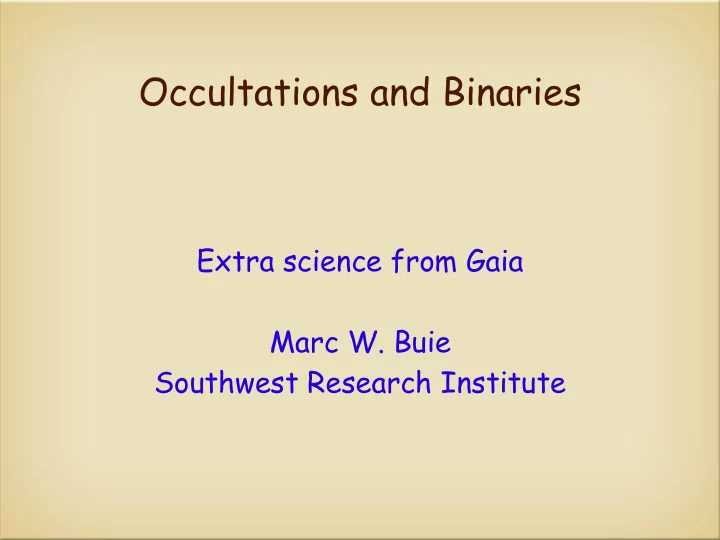

Occultations and Binaries Extra science from Gaia Marc W. Buie Southwest Research Institute
Occultations – Figure of Merit ● Q = 2σΔ/D ● Dimensionless characterization of probability of successful observation ([σ]=radians; [Δ,D]=km) ● N T = 3(Q+1) ● Number of telescopes needed to get three chords across diameter of object. ● Q=0, no error, you know where to be 2/16 Buie - Gaia/Pisa, 2011 May 5
Importance of positional accuracy ● Baseline: σ = 1”, Δ=1 AU, D=100km; Q=14.5 ● Main belt: Δ=3 AU, σ = 0.01”; Q=0.4, N T =4 ● Outer: Δ=30 AU, σ = 0.001” for N T =4 ● σ = 0.01”; Q=4, N T =40 (fixed network) ● Distant ● σ = 0.1 mas → Δ=300 AU ● σ = 0.01 mas → Δ=3000 AU 3/16 Buie - Gaia/Pisa, 2011 May 5
Occultation Observation Type Type Fixed Portable Network Low-Q Good for large Excellent – high Useful but can't pick (Jupiter, Titan, some objects, target of density sampling events asteroids) opportunity Modest-Q Excellent, Rare, Good – requires Excellent – need (Pluto, Triton, most easy to do large effort decent target main-belt asteroids) sample High-Q Very low return, Poor – effort too Good – need large (average TNOs, rarely worth effort large target sample small asteroids, NEOs) Q~∞ Not useful Not useful Possible with very (small TNOs) large sample 4/16 Buie - Gaia/Pisa, 2011 May 5
Asteroid occultations vs. time 5/16 Buie - Gaia/Pisa, 2011 May 5
Asteroid occultations vs. time 6/16 Buie - Gaia/Pisa, 2011 May 5
Asteroid occultations vs. distance 7/16 Buie - Gaia/Pisa, 2011 May 5
Asteroid occultations vs. distance 4+ TNOs Chiron Pluto Triton 8/16 Buie - Gaia/Pisa, 2011 May 5
Example result 9/16 Buie - Gaia/Pisa, 2011 May 5
Example result Star = 9.9, Δm=3.5 10/16 Buie - Gaia/Pisa, 2011 May 5
Current challenges ● Small objects ● Small region of action, difficult if not impossible to get shapes with multiple chords ● Distant objects ● Large objects can be done with large effort ● Medium objects require different observing strategy (RECON) ● Both star and object not well enough known 11/16 Buie - Gaia/Pisa, 2011 May 5
Classical TNOs ● Low- e and low- i , a ~ 43AU ● “100km” class object ● Most were not-detectable with Spitzer ● Implies, cold, high-albedo, smaller size ● Highest rate of binaries (≥10%) ● Least disturbed remnant of solar system formation ● Second New Horizons destination 12/16 Buie - Gaia/Pisa, 2011 May 5
RECON Research and Education Cooperative Occultation Network ● Targeting 100-km class TNOs ● V<13 (at limit gives size good to 10%) ● Fixed network of 28cm telescopes ● simple instrument (no computer) ● $5,300 per system (off-the-shelf hardware), includes telescope ● 40 stations, 1800 km spread, 48 km mean spacing ● Staffing with educators and students, rural communities ● Works for Q up to 12 (can constrain tight binaries on low-Q events) 13/16 Buie - Gaia/Pisa, 2011 May 5
Additional Considerations ● Small or distant objects will be routine ● Prediction effort is simplified ● Catalog search for target stars ● Object astrometry directly tied into catalog ● No proper motion catalog degradation ● Predictions no longer time dependent ● Deployment can be planned well in advance ● No more last-minute border crossings ● More credibility for large telescope requests 14/16 Buie - Gaia/Pisa, 2011 May 5
Binaries ● Key to formation and evolution models ● Discovery ● Rate of duplicity, “size” ratio (statistical result is good) ● Orbits ● System mass, component masses, aggregate orbital properties ( a , e , i ) ● Mutual events, albedos, shapes, tidal evolution, densities 15/16 Buie - Gaia/Pisa, 2011 May 5
Gaia related issues ● Look for co-moving sources ● Quick release needed to enable followup and more detailed characterization ● Look for departure from normal PSF that repeats within scan ● Need to eliminate background star confusion ● This will be a result from entire mission ● Astrometric deviations will indicate unseen companion 16/16 Buie - Gaia/Pisa, 2011 May 5
Recommend
More recommend